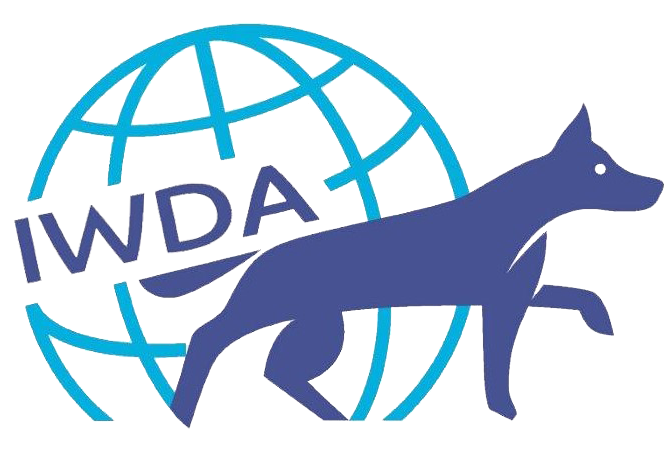Search for working dog conference recordings, articles on health, breeding, socialization and organizational management, webinar recordings and more.
Old Conference Archive Page | View all IWDC 2023 Recordings | View all Breeder's Workshop Colorado Recordings
-
Organization Management
-
Canine Resources
-
- Articles coming soon
-
-
- Emotional Conflict During Socialization
- What is environmental enrichment?
- Distance, Distraction and Duration
- Developing Foundational Skills
- Luring, Marking & Giving Food
- 5 Steps to Progressing Skills
- Dog-Human Relationship Skills
- Utilizing Volunteers
- Biosecurity
- Biosecurity protocol documents
- Example Socialization Schedule
- Puppy Socialization Tracker
- Crate Training
- Managing Inappropriate Interactions between littermates
- Preventing and Fixing Door Dashing
- Follow Me: Video
- Bath Progression: Video
- Intro to New Environments: Video
- Motor Development: Video
- Novel Objects: Video
- Novel Sounds: Video
- Trolley Ride: Video
- Wearing Things/Coat Desensitization: Video
- Carrying Puppies Safely
- Safely Using Stairs: Video
- Puppy Confidence Course
- Socialization Ideas Gallery
- Weighing Puppies: Video
- Birth of a Puppy: Video
- First Time Outside the Den: Video
- First time Exploring the Garden: Video
- Exploring the garden in the dark: Video
- Include puppies in the daily work routine: video
- Collar Habituation: video
- Exploring a wobble board
- Exploring the world - unfamiliar surroundings
- Walking around the grounds
- Socialization opportunities in daily life
- Walk in the woods
- Exploring the world
- Free time for moms
- Explore the stairs and garden
- Explore the puppy garden
- Show Remaining Articles ( 28 ) Collapse Articles
-
- Articles coming soon
-
Education
-
-
- A Behavioral Questionnaire for Selection and Study of Odor Detection Dogs - Presented by Cynthia Otto
- Audeamus PTSD Service Dogs, ACAC Accredited Peer-Support Model for Veterans and First Responders - Presented by Chris Lohnes and Grace Rath
- Audeamus Service Dogs and University of Saskatchewan Research Partnership and Outcomes - Presented by Chris Lohnes & Grace Rath
- Building a Purpose Bred Breeding Program - Presented by Allison Peltier and Rachel Goldammer
- Core body temperature and activity level changes during work and exercise in patrol dogs of the Queensland Police Service - Presented by Jayne McGhie
- Detection of Heterobasidion parviporum scent samples in indoors scent discrimination test by trained volunteer dog-handler teams - Presented by Heli Väätäjä
- Development of a Tool to Aid in the Selection and Pairing of Breeders based on Behavioral Traits - Presented by Jordan Smith
- Early Detection of Heat Stress in Working Dogs - Presented by Andrea L. Henderson
- Effects on behavior and physiology of handling style during veterinary visits - Presented by Karen Overall
- Field cooling for exertional hyperthermia - Presented by Cynthia Otto
- From Anxious to Resilient: The Role of Dynamic Interactive Engagement in Shaping Military Working Dogs - Presented by Melanie Uhde
- Genetic Resources to Improve Dog Health - Presented by Angela Hughes (Royal Canin)
- Genomic research in the Working Dog Field: Combating Canine Cancer through Collaboration and Comparative Oncology Research - Presented by Frances L. Chen
- Handler Perceived Risks to Operational Detection and Patrol Police Dogs - Presented by Jayne McGhie
- Improving Trauma Patient Care - Presented by Kelly Hall
- Neuromuscular Balance Training in Working Dogs - Presented by Andrea L. Henderson
- Occupational Risks and Specialized Veterinary Care for Working Dogs - Presented by Cynthia Otto
- Putting working dog research into practice: development of science-based guidance notes - Presented by Fiona Williams
- Rating of Perceived Exertion in Working Dogs - Presented by Andrea L. Henderson
- Real-world experience with liquid biopsy testing for cancer detection in working dogs - Presented by Jill Rafalko
- Specialty Practice Behavioral Problems and Outcomes in Companion Dogs - Implications for Working Canines - Presented by Walt Burghardt
- Start of life – Feeding during pregnancy and lactation to increase reproductive success - presented by Angela Hughes (Royal Canin)
- Teaching Collar Yielding as a Foundation Behavior - Presented by Patrick Glines
- The Doberman Diversity Project: a Citizen Science approach to breed improvement - Presented by Sophie Liu
- The effect of inhibitory control, arousal, and affective state in Military Working Dogs Performance - Presented by Astrid Concha
- The effect of training aid volume on odor generalization in detection of chronic wasting disease in deer - Presented by Mallikarjun and Wilson & Cindy Otto
- The Many Dogs Project: A Big Team Canine Science Effort - Presented by Sarah-Elizabeth Byosiere
- Transformative Power of Freedom of Choice in Changing Behavior - Presented by Marty G. Roache
- Turning a Critical Eye on an Established Breeding Program to Improve End Results Using IWDR - Presented by Natalie Ergler and Rachel Goldammer
- U.S. Military Working Dog Welfare - Presented by Desireé Broach
- What is the future of Biological Detection Canines? - Presented by Heather Junqueira & Ken Furton
- Working dog memory and canine gut microbiome - Presented by Xu Wang
- Show Remaining Articles ( 17 ) Collapse Articles
-
- Breeding Healthy Dogs - Presented by Madeline Zimmermann
- Choosing What to Breed For - Presented by Madeline Zimmermann
- Gaiting - with Doug & Colton Johnson
- Genetic Merit Selection - Presented by Madeline Zimmermann
- Improving Behavior - Presented by Jane Russenberger & Dr. David Roberts
- IWDR: Storing your Data - Presented by Rachel Goldammer
- Keep Data on Everything! - Presented by Rachel Goldammer
- Long-Term Colony Management: Balancing genetic improvement breeding for the whole dog - Presented by Dr. Eldin Leighton
- Power of Numbers: IWDR Functions - Presented by Rachel Goldammer
- Producing Puppies - Presented by Dr. Fiona Hollinshead and Dr. Greg Burns
- Puppy Socialization - Presented by Jane Russenberger
- Puppy Socialization for Handling - presented by Doug & Colton Johnson
- Reading Dog Behavior/Emotional States - Presented by Dr. Karen Overall
- Whelping and Neonatal Care - Presented by Dr. Fiona Hollinshead and Dr. Greg Burns
-
- "All about the boy" - Semen Collection and Analysis - presentation by Dr. Fiona Hollinshead
- All about the brood - presentation by Dr. Greg Burns
- Behavior Checklist (BCL) Workshop - with Helen West
- Behavioral scoring in Puppy Raising - presentation by Helen West
- Brood and Whelping Concerns - presentation by Dr Greg Burns
- Calculating Differential Risk of Osteoarthritis in Dogs with Low vs High Hip Scores - presentation by Dr Tom Lewis
- Cardiac diseases - presentation by Dr Kevin Conrad (absent); presented by Dr. Kyle Quigley
- Conditioning Program for Dogs Coming In For Training - presentation by Dr Kevin Conrad (via zoom)
- Critical periods of socialization and impact on temperament of the dog - presentation by Jane Russenberger
- Does early potty training affect indiscriminate relieving? - presentation by Dr Lynna Feng
- Dog behavior is in the eye of the beholder - presentation by Joke Monteny
- Entropion - presentation by Jenna Bullis
- Feeding for Breeding Success - presentation by Dr. Emmanuel Fontaine
- Gait and Structure Evaluation for Guide Dogs - presentation by Peggy Gibbon and Dr Katy Evans
- GDBart Puppy Test - presentation by Helen West
- Healthy microbiome and faecal transplants - presentation by Dr Kevin Conrad (absent); presented by Dr Caroline Moeser
- Hip and elbow assessments - with Dr Bart Broeckx
- How to make breeding decisions on traits without EBVs - presentation by Madeline Zimmermann
- How to use estimated breeding values successfully - presentation by Madeline Zimmermann
- Improving behavior with EBVs: Body sensitivity, Noise Fear, Inhibited by Stress, Activated by Stress, Excitable - presentation by Jane Russenberger
- Improving health using EBVs: Elbow, Skin and Mast cell tumours - presentation by Madeline Zimmermann
- Is it really epilepsy? - with Dr Bob Proesmans & Dr Caroline Moeser
- Neonatal Care - presentation by Dr Emmanuel Fontaine
- Reproductive Trends and Cryogenic Insights from Guiding Eyes - presentation by Clover Williams
- Selecting Reproductively Healthy Dogs - presentation by Dr Emmanuel Fontaine
- Skin allergies - with Dr Caroline Moeser
- Stargardt's disease in Labrador retrievers - with Dr Katy Evans
- Strategies for genetic diversity - presentation by Jackie Clark and Dr Bart Broeckx
- Superficial Digital Flexor Tendon Avulsion - presentation by Dr Caroline Moeser
- The art of insemination - presentation by Dr. Fiona Hollinshead
- The Overall Selection Index - presentation by Dr Eldin Leighton
- What influences semen quality? - presentation by Dr. Tom Lewis
- Show Remaining Articles ( 17 ) Collapse Articles
-
- A detailed evaluation of Spotted Lanternfly (Lycorma delicatula) detection dog training and performance - Presented by Edgar O. Aviles-Rosa
- A novel method for the detection of Japanese knotweed (Reynoutria japonica) using specially trained canines - Presented by Kat Janczur
- AKC Detection Dog Task Force Program: Working with AKC Breeders to Improve Breeding & Availability of Explosives Detection Dogs - Presented by S Goffe
- Assessing working dog fitness with the Penn Vet Working Dog Center Fit To Work program - Presented by Brian Farr
- Assessment of the Agreement between Fosters and Trainers Evaluating Behavior with the C-BARQ and Behavior Checklist presented by Elizabeth Hare
- Behaviour Assessment and IWDR - Presented by Dr Jane Russenberger
- Breeding Strategies and Advanced Reproductive Techniques to Optimize Production of Improved Generations of Specialized Canines at Three major working dog breeding programs in New Zealand - presented by Dr Fiona Hollinshead
- Development and heritability of cognitive traits in Canine Companions dogs presented by Emily Bray
- Digital innovation for working dogs - Presented by Dr Mia Cobb
- Discrimination between SARS-CoV-2 infection and other viral respiratory infections by working dogs - Presented by Nele ten Hagen
- Effect of impulsivity and core effect on training performance in dual purpose military working dogs - Presented by Astrid Concha
- Epilepsy in working dogs - Presented by Prof Holger Volk
- Estimated Breeding Values in IWDR - Presented by Dr Eldin Leighton
- Examining the Role of Significant Others in Canine Welfare within the Context of Veterans Working with Service Dogs - Presented by Linzi Williamson
- Explosive detection canine operational requirements and performance degradation: expert perspectives - Presented by Brian Farr
- Hot Topics in Working Dog Care - Presented by Dr B. Pierce & Dr K. Mann
- Implementation of a plan to decrease arousal and increase motivation - Presented by Robert Dougherty Jr and Alena Heyer
- Improving behavior monitoring within a working dog program - Presented by Becky Hunt
- Incidence of enteric pathogens versus presence of gastrointestinal symptoms in a working dog training facility - Presented by Dr Nicola Cotton
- Investigation of tail injury at Lackland Air Force Base Training Kennels for Military Working Dogs - Presented by Marty G. Roache & Karen L. Overall
- Learning to Smell: Impacts of Training and Experience on Detection Dog Performance - Presented by Nathaniel Hall
- Lecture on Generalization in Detection Work - Presented by Hans Ebbers
- Liquid biopsy screening for early cancer detection in working dogs - Presented by Katherine M. Lytle, DVM, MPH, MS
- Military Working Dog Aggression and Welfare - Presented by Desiree Broach
- Multimodal characterization of detection dog suitability: Combining behavioral, cognitive, and neurological measures for enhancing selection - Presented by Lucia Lazarowski
- Overview of the IWDR for Working Dog Organizations - Presented by Dr Eldin Leighton
- Pandemic or pandemonium? Creating standards for medical detection dogs - Presented by Dr Cynthia Otto
- Penn Vet Working Dog Center Fit To Work program foundational fitness development and training - Presented by Meghan Ramos
- Preliminary Accuracy of COVID-19 odor detection by canines - Presented by Kenneth G. Furton
- Prevalence of Canine Degenerative Myelopathy SOD-1 Mutation in Working Shepherd Dogs across Australia and New Zealand - Presented by Jayne McGhie
- Scent dog identification of SARS-CoV-2-infections- a double blind study - Presented by Esther Schalke
- Solving cold-cases: Dogs can match human scents collected several years apart - Presented by Margot Perez
- The Application / Practical Implementation Pro/Cons of Covid-19 Olfactory Detection Dogs - Presented by Prof D Grandjean
- The Domestic Breeding Consortium: Odor Detection Canine Selection, Breeding, and Early Training Techniques - Presented by Karen Meidenbauer
- The effect of maternal style on later puppy behavior in Canine Companions dogs - Presented by Brenda Kennedy
- The use of historical health records at The Seeing Eye in genome-wide association studies for canine health traits presented by Katy M. Evans
- Training with Varying Odor Concentrations: Implications for Odor Detection Thresholds in Canines - Presented by Mallory DeChant
- Transitioning a Therapy Dog Program Online: What's In It For the Dog? - Presented by Ben Carey
- Using IWDR's Advanced Tools to Improve HeaLth and Behaviour - Presented by Dr Eldin Leighton
- Using Single-Step Genomic BLUP to Compute Genomic Enhanced Breeding values for Self-Modulation in Working Dogs presented by Molly Riser
- Using trained dogs and organic semi-conducting sensors to identify asymptomatic and mild SARS-CoV-2 infections - Presented by Dr Claire Guest and Prof James Logan
- Working Dog Welfare: Where are we now and where are we going? - Presented by Dr Mia Cobb
- Show Remaining Articles ( 27 ) Collapse Articles
-
- A canine thermal model for mitigation of heat strain in working dogs - Presented by C. O'Brien
- Building a better detector dog: Lessons learned and (many) questions remaining to be explored in Auburn University’s 19 years of detector dog production - Presented by P. Waggoner, PhD
- From Puppyhood to Adolescence: Longitudinal Cognition Study at Canine Companions for Independence - Presented by K. Levy
- Genome-wide association studies to identify loci and variants associated with behavioral traits in dogs - Presented by V.D. Marinescu, PhD
- Hyper-reactivity in military working dogs: a report of two cases - Presented by O. Soares, DVM, PhD
- Measuring, and determining factors affecting performance of glycemic alert dogs - Presentation by N. Rooney, PhD
- Neuromotor development in puppies: implications for training and fitness - Presented by B. Pierce, DVM, MS, DACVIM, DACVP, DACVSMR
- Odour generalisation – theory and practice - Presented by A. Schoon, PhD
- Putting working dog research into practice: development of science-based guidance notes - Presented by V. Ratcliffe, PhD
- Referential focus - pet & working dogs - Presented by K. Overall, MA, VMD, PhD, DACVB
- Statistics for working dogs – how do you know if your test/assessments are better than a coin toss? - Presented by A. Dunham, PhD
- Temperament and EBV - Presented by Erling Strandberg, PhD, SKK
- Testing dogs for behaviour in Sweden: Canine temperament - assessment and heritability & How you assess temperament - presented by Åke Hedhammar DVM, PhD & Kenth Svartberg, PhD
- The chemistry of odor: How understanding odor can foster a better detector - Presented by L. De Greeff, PhD
- The opioid crisis and working dogs - Presented by C. Otto, DVM, PhD, DAVCECC
- What helps and what hinders assistance dog/puppy raising practices? - Presented by Doc Loc Mai (Jimmy)
- Working Dog Centre: Working hard for working dogs - Presented by W. Baltzer, DVM, PhD
- Show Remaining Articles ( 2 ) Collapse Articles
-
- BCL Workshop with Rachel Goldammer
- Anchor at Sea: Breeding for the Whole Dog - presented by Dr Eldin Leighton
- Picking and Managing Breeder Candidates - presented by Madeline Zimmermann
- GDB Whelping Box Fleece and Hip Dysplasia Study - presented by Dr. Kris Gonzales and Lauren Holtz
- The Importance of Longitudinal Behavioral Data - presented by Dr. Dave Roberts (NCSU), Jane Russenberger
- Lifetime Health Data: Critical for Your Decision-Making - presented by Jane Russenberger
- Fighting Cancer with Genomics: Developing Breeding Values to Reduce Hemangiosarcoma Risk and Unlocking DNA insights - presented by Frances Chen
- Discovery of Early On-Set PRA - presented by Glenna Fiddyment
- Suspected autosomal recessive primary ciliary dyskinesia in a colony of Labrador Retriever guide dogs - presented by Katy Evans
- Small Litter Whelp Protocol and Utilizing Best Practices in a 24-Hour Whelping Facility - presented by Kristine Gonzales
- Genetic and genomic investigations into canine atopic dermatitis - presented by Dr Tom Lewis
- Puppy Socialization Application with limited Staff and Resources - presented by Natalie Ergler, Guide Dogs of America
- Low-Pass Whole Genome Sequencing: Equipping the Working Dog Field with Next-Generation Genetic Tools Through Research Partnerships - presented by Frances Chen
- Smart Collar Project - presented by Dr. Dave Roberts
- Canine Genetics And Genomics: A Primer - presented by Dr Eldin Leighton
- Harnessing the Power of Longitudinal Data in IBC: Insights, Challenges, and Applications - presented by Dana Hunter
- Repro Techniques Demonstration and Discussion: Examination of the male - presented by Dr Gary England
- Repro Techniques Demonstration and Discussion: Examination of the female – presented by Dr Gary England
- Show Remaining Articles ( 3 ) Collapse Articles
-
- Unifying the Canine Detection Community: The Impact of Standard Development on Global Practices - Presented by Paola A. Prada-Tiedemann
- Utilizing scent detection dogs in the early detection of Ips typographus damages - Presented by Reetta Kangaslampi & Dr Olli-Pekka Tikkanen
- The Detection of Oil Under Ice and Water by Oil Detection Canines - Presented by Paul Bunker
- Quality Management and Deployment of Mine Detection Dogs: NPA Approach - Presented by Kenan Muftic
- Breeding on a (Shoestring) Budget - Presented by Patrick Glines
- Remote detection - Presented by Jens Frank
- From Laboratory Insights to Operational Efficiency - Presented by Joshua Araujo
- Foundational Skills for Greater Success in the Working Dog - Presented by Jane Madigan
- What olfactory psychophysics and ethology can contribute to work with sniffer dogs - Presented by Simon Gadbois
- The impact of distraction training on dogs’ learning and task performance - Presented by Carla Hart
- Training a cadaver detection dog - Presented by Hans Ebbers & Marco Muglia
- Vapor Diffusion in Soil: Simulated Explosive Burials and Canine Trials - Presented by Emma Calabrese
- Optimising Police Dog Breeding and Development for Operational Performance - Presented by Scott Bruce
- Building Successful Partnerships with Private Breeders for Working Dog Programs - Presented by Laura Edwards
- Lessons learned from training dogs to detect plants - Presented by Kat Janczur
- Identifying when early puppy behaviors deviate from ‘normal’ and implications for development of behavioral pathology - Presented by Karen Overall
- Collaborative canine genomics: developing the next generation of genetic selection tools in working dogs - Presented by Frances Chen
- Genomic estimated breeding values on health and behavior traits to inform breeding and management of working dogs - Presented by Heather Huson
- Overview of maintaining genetic diversity - effective population size - practical applications in a breeding program - Presented by Tom Lewis
- Human Animal Bond- Contact-Free Simultaneous Sensing of Human Heart Rate and Canine Breathing Rate for Animal Assisted Interactions - Presented by Dave Roberts
- Dietary Management of Working Dogs: More than Just Calories - Presented by Erin Perry
- UK ISAR Dogs in the 2023 Türkiye-Syria Earthquake Response - Presented by Lyndsay Sielski
- Understanding and meeting the welfare needs of working dogs - Presented by Sam Gaines
- Decoding Disease Detection - Presented by Claire Guest
- Mind the Gap: Human Perceptions, Canine Preferences, and the Importance of Welfare Assurance in Working Dog Programs - Presented by Mia Cobb
- Stress travels down the lead but also through the air - Presented by Nicola Rooney
- Suspected autosomal recessive primary ciliary dyskinesia in a colony of Labrador Retriever guide dogs - Presented by Katy Evans
- Nutritional Needs of Working Dogs - Presented by Caroline Burke (Royal Canin)
- An examination of the latest research relating to kennelled dog welfare - Presented by Dr Jenna Kiddie
- Can a synbiotic provided to puppies affect the incidence of diarrhoea during the transition from nest to puppy raiser? - Presented by Madeleine Goumas
- MWD Functional Assessment - Preserving the Fighting Force - presented by Andrea Henderson
- From Can't Get Right to Law Enforcement K9 - Daniel's Story - presented by Marty Roache & Angel Landrau
- Multi-modal Treatment of Diarrhoea and the Importance of the Microbiome - Presented by Michelle Van Lienden
- Show Remaining Articles ( 18 ) Collapse Articles
-
-
-
- Veterinary Genetics with Dr Angela Hughes
- Optimizing Volunteers for Early Socialization Success with Liz Rote
- Inbreeding in Working Dog Colonies with Dr Eldin Leighton
- Partners in crime - help puppy raisers turn fun policing upside down - with Matthias Lenz
- Improving Digital Processes and Datakeeping for Volunteers and Working Dog Programs - with Dani Prebensen
- Walk and Talks: Beyond the Data - with Jackie Clark
- Building a Healthy Relationship with Your Nonprofit Board - With Laura Edwards
- Identify and Build a Healthy Nonprofit Board – With Laura Edwards
-
-
-
Payment and Accounts
Quick Reference Guide

Goal
Build puppy’s bond with humans through praise, petting and food; Carefully monitor the puppies for any fear responses. Build up puppies’ “memory bank” of positive experiences.

Environments
Around your facility – such as outdoor play areas, rooms near the den, or puppy-proofed locations for “onsite field trips”. Introductions to van/car and bath.

Volunteer Activities
A variety of volunteers with an active understanding of puppy body language and reinforcing positive behaviours
Introduction
Massive brain development continues this week. Milestones include near adult vision and an innate inquisitive about their environment. The motor skills are more advanced so the environment can include larger objects for pups to climb over, go through or stand on.
Enhanced proprioception ability enables pups to enjoy more advanced motion equipment. This is the time to offer a more enriched environment full of different visual, sound, movement, surfaces as well as a large variety of people of all ages. During this age group there is a huge potential to influence just how sound and confident the puppy will become as an adult.
This week we continue to look for signs that the puppy is going through a fear period where they start to development a fearfulness of their environment. Even a familiar environment can produce a reaction at this time.
German Shepherds are a more reactive breed and can enter this critical fear period as early as 5 weeks whereas Labrador Retrievers are a less reactive breed and may not enter this stage until 10 weeks of age. It is a gradual process so be mindful about this development stage and treat each litter as an individual group and not according to a set standard.
Make sure you’re familiar with our guide to Emotional Conflict during Early Socialization.
- Pup is in the Engaged (Green) zone most of the time: they will happily explore a new environment, play with littermates then fall asleep, and accept familiar handling techniques, surfaces, objects and textures without issue.
- Pup is engaged with the handler or environment most of the time (not hiding, overly stressed, or shutting down). Pup’s confidence will increase as it interacts and learns that its environment is constantly changing.
- The addition of unfamiliar stimuli is accepted with minimal issue, and additional exposures to stimuli show improvement in the puppies’ comfort levels.
- Alternatively, pup is conflicted briefly then moves back into the green zone once it has resolved the internal conflict. (Pup displays 1 or 2 stress signs (yawning, whining) it quickly resolves inner conflict without escalating to additional stress signals; Second exposure pups are more confident with a reduced number of stress signals. Look for an improvement in the pup’s confidence with each exposure to the stimuli. If the pup has displayed 2 or 3 stress signals, set pup up for success and aim for less next time by building the pup’s confidence.)
For more information on puppy engagement during socialization, read our article on Emotional Conflict During Socialization here.
Puppies are more susceptible to fear reactions beginning this week. Extra caution should be taken to focus on building positive experiences and exposures to build confidence.
Pups still need large amounts of sleep. Do not over stimulate the pup. It cannot learn in this mode
Utilise the natural curiosity of young pups when introducing new environments and build up positive association around change prior to the startle/fear stage that occurs later.
Observe pup and adjust procedure appropriately so it is a positive learning experience. Each pup is worked as an individual and techniques are for this pup not the whole litter.
Early repeat exposure in different environments will add to pup’s confidence and ways to resolve inner conflict.
Keep it brief: Remember pups have short attention spans. A successful exposure may be only seconds long and an entire education session should be no more than 5 minutes.
Keep your objective in mind: Since puppies have short attention spans, it is important to focus on the task at hand. While it is very tempting to snuggle a puppy before working with them, this can take away from the puppy’s purposeful learning for the day as they are able to work for noticeably short periods of time
Give the puppy an “escape route”: When an activity has gone on too long, is too overwhelming, or too challenging, a puppy needs a means to avoid it. If a puppy uses the escape route frequently, stop and seek assistance. Large objects, tunnels, gap behind crate can offer a pup a safe area to resolve their inner conflict.
Adaptability is an important skill in working dogs. Teaching pups to accept daily changes in environment, handling and routine during this age group will help them generalise to any environment in their working life.
Teaching pups to interact with their environment without overreacting is an important skill in producing sound working dogs.
Teaching these skills during the early critical learning period will produce better results than introducing it after 12 weeks of age when pup is not as adaptable to changes.
Increasing the pup’s repertoire of positive associations around new and novel objects and environments will result in resilient dogs.

Problem Solving
- Review our massage and body handling protocols. Make sure you’re not progressing too quickly. Reduce time then slowly build up again.
- Use smaller sessions to focus on targeted improvement of problem areas during the body handling process. (For example, if pup struggles with having its feet touched, try some shorter desensitisation sessions focused on touching the puppy’s feet calmly and gently, paired with high value rewards). Remember, this is just the beginning: note down these problem areas and measure your improvement over time. Aim for progress, not perfection!
- Ensure all staff move pups slowly and each pup is fully supported. Make sure not to move pups quickly through the air.
Should pup show concern around crating remember it is helpful to feed pups in their crates individually at this stage with the door closed in order to build this positive association around crates.
Once finished feeding take pup out to drink and toilet helping to promote clean pups.
When crating at other times ensure pup has toys and some form of food source (e.g. kong, chew or nylabone with peanut butter on end). Reward quiet behaviour with a treat.
If a puppy has a significant change in energy and/or needs a longer time to recover, give the puppy time to resolve the conflict on their own. The handler can give the puppy support and encouragement with voice and soft petting. If the puppy has a severe change in energy and is no longer able to be engaged with the handler and activity, end the session on a positive note and return the puppy to their litter.
- Allow pup time to resolve inner conflict themselves
- Offer emotional support via voice and touch
- Shorten duration of visit. If one pup displays distress signs (whining) the others will usually follow. Be prepared to move when all pups are quiet so as not to reinforce a negative behaviour (whining gets what I want)
- Engage with pup using favourite toy
- Look for an improvement in the pup’s confidence with each exposure to the stimuli. If the pup has displayed 2 or 3 stress signals, set pup up for success and aim for less next time by building the pup’s confidence.
Utilise supports like mom, littermates, or a known handler. In a similar manner to mom during the previous few weeks, a confident littermate can assist a concerned puppy by interacting with the item in question, showing the concerned pup that the item is safe. A handler can provide verbal support, petting or food to build positive associations with the item in question, though ideally, give the pup an opportunity to reach a positive conclusion on its own and thus develop those important problem solving and adaptability skills.
Stop and place hands around pup’s chest area. Do some gentle circular motion with your hands. Once pup is calm again you can resume the body handling.
It can help to go back to an area on the body that pup is comfortable being handled and try again.
Should pup still not be comfortable reduce the session times then build up again.
Try luring with slower, more deliberate movements. Make sure you have pup’s interest in the lure and maintain that connection. Practice moving your arm with a “mixing bowl” movement – wide, sweeping and steady.
Passive Environmental Enrichment
Passive exposure continues by exposing pups to a variety of surfaces, sounds, movement, objects in their crate and den environment.
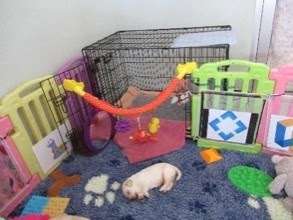
Acceptance of change and difference can be achieved by placing 1 random object into the nest each day that the puppies have not been exposed to before (backpack, hat, purse, statue like objects). Observe and record each pup’s reaction to the novel object.
Below we have marked each activity with one to three ✓. Although all activities are important, we have highlighted activities that are particularly critical during this period of the puppies’ development. Make sure you still offer the pups a wide variety of activities and do not only focus on those with the most ✓!
Our pups are developing great hearing, sight, smell and motor skills. Make sure to keep rotating a variety of items in their den environment – Variety is important to keep pups inquisitive and accepting of change.
Make sure to emphasise different surfaces: putting new surfaces in your den rotation is great for passive socialization.
Some examples of items to introduce include:
- Toilet Box (To be used if needed by pups in between toilet breaks)
- Ramps between areas (for example, ramps between indoor and outdoor pens, or up into a slightly elevated crate)
- New sounds – search on Youtube for soundtracks: Weather sounds, Cafe/kitchen sounds, children playing, cartoons or episodes of shows, etc.
- More visuals: Posters or print-outs of patterns at puppy-eye height and items that are brightly coloured.
- Surfaces: Different fabrics, household surfaces like tiles or wood, cardboard, concrete, fake or real grass, and other more complex and creative surfaces
- Novel objects: Mannequins dressed in weird and wonderful outfits; statues of dogs or statues found at garden centers
- Hanging toys: These help develop puppies’ perception of items above their head. Wind chimes, baby mobiles, streamers. (Make sure hanging toys are at an appropriate height as to not risk puppies being caught up in them.)
- Hard Chew Toys (puppy appropriate!) can be introduced.
Note this video covers multiple age groups. Please see the section from 3:08 – 5:13 for content appropriate for this age group.
- Working dogs encounter a variety of sounds throughout their career. Some dogs may travel with their partner through busy cities while others may go to the Opera or loud concerts with their partner. With all of the different sounds a dog may encounter, we want our puppies to be comfortable and confident with many different sounds during their critical socialization period.
- When exposing pups to new sounds, think about variety. Music can include jazz, classic, country, pop, or simply putting on the radio.
- Playing the news or weather report on the TV or radio exposes pups to different voices and different types of sound.
- Music can be played quietly on a radio or computer in the same room as the whelping box for about an hour per day.
- If Mom is uncomfortable with items or will chew items up, only place them in the den under supervision for a short period of time.
Working dogs must be accepting of a variety of novel objects they may encounter in the community; so, it is important that at an early age they begin to build their reference library of unusual items, including those that move, so that they are comfortable and confident with different novel objects.
Ensure you introduce a large variety of new people, start gradually to build up pup’s acceptance of difference. Demographics to cover include; young, elderly, male, female, toddlers, different ethnic groups. Here is a list to get you started:
- Men, women of different ages (see note below on children)
- Men with facial hair/beards
- Large and small people / tall and short people
- People using different mobility items: wheelchairs, white canes, walking canes
- People holding umbrellas
- People with bulky handbags, backpacks
- People wearing hats
- People wearing glasses
- People who speak loudly; laughing people
- People from a distance (for example, knocking at the door) – both visiting pups and not visiting pups
- People making erratic movements
- People sitting on the floor or on chairs
- People standing and talking together
A note regarding children
When socializing your pups with children, be careful to introduce young puppies to calm children who understand how to appropriately interact with the pup. If possible, letting the pup see and hear children without direct interaction can be helpful. Children can be loud, smelly (with tasty morsels on their clothes and face), and move erratically. Children can also react to puppies in ways that either encourage puppies to chase them, or alternatively might scare the pup. It’s ideal to have a few initial interactions at a distance or with calm children to build a healthy foundation, particularly when socializing younger puppies.
Additionally, make sure children are gentle with the pups – hold the puppy yourself and encourage the child to gently pat the puppy; or get the child to sit on the ground before placing the pup in their lap. Do not leave puppies and children unsupervised, and do not let children hold the pup in case they accidentally drop the pup!
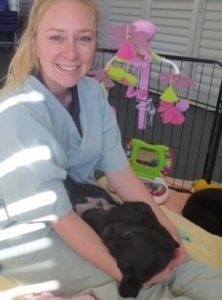
It is important for working dogs to be comfortable with walking over different types of surfaces such as grates and uneven pavements. Puppies learn quickly that walking over bumpy and open surfaces is completely normal.
It is important to have a variety of surfaces for the puppies to walk on so they do not grow accustomed to only walking over one particular surface. When selecting equipment, think of having different textures and materials.
More challenging surfaces can be added in the litter’s room to encourage them to climb and walk over different surfaces. This helps build the puppy’s confidence and also their muscles!
You may find your socialization items cover multiple objectives: for example, a textured wobble-board is both a new surface and a motion item; or tiles might be loud when puppy nails tap on them. Take this into consideration when choosing items appropriate for your puppies, and recognise that these items might be quite challenging for some pups.
Get creative – but keep in mind that the surfaces need to be age and skill appropriate. Some ideas for new surfaces could include:
- Baking trays tipped upside-down (could be slightly wobbly)
- Milk crates or pallets
- Trays with a small amount of water in them (to replicate puddles)
- Sand, bark, gravel (supervised)
- Wooden panelling
- Tiled floors (also consider the noise of the floor and the room, e.g. echoes in a bathroom)
Passive open crate exposure is the foundation to crate training. Puppies can explore the crate and go in and out as they wish. Hard plastic crates can be used if the front door is taken off to prevent puppies from becoming stuck in the crate. The latch can be securely fastened back (or the door is removed) in a metal crate.
Although this is a passive activity, we recommend someone is in the general area to listen out in case any issues arise.
Soft bedding and interactive toys will help to promote positive associations around the crate.
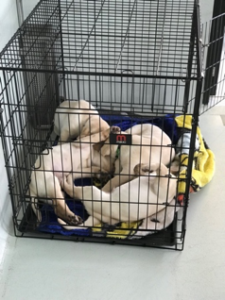
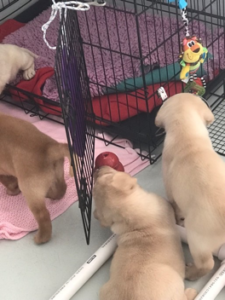
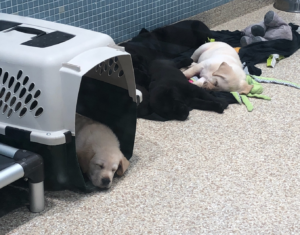
- Read more on crate training here.
- Review our Biosecurity protocols if your crate is positioned outside the pup’s normal pen.
Working dogs need to be comfortable walking on unstable objects and comfortable with objects that move. It is important that puppies learn to be confident with walking on unstable objects and being around moving objects.
One useful item to introduce motion are exercise cushions or wobble boards. These tools can help pups develop muscle and motor skills and can often be adjusted to add more complexity/movement as the puppies grow. (For example, a mostly deflated cushion gives young pups an unusual but secure surface with some movement – the same cushion when fully inflated could be a suitable challenge for confident 8 week old pups). When using these tools, make sure to introduce them as secure items with very little movement so your pups aren’t frightened. Use foam or towels as padding which can easily be removed as your puppies grow.
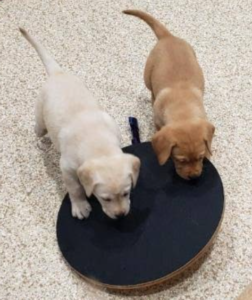
Interactive Activities
During interactive activities, we continue to promote the puppy handler bond. Previously, “one on one time with a handler” was listed as its own activity, with the goal of developing a healthy puppy-handler relationship. After the foundational work of the previous few weeks, more and more of these interactive activities can be done in small groups or “one on one” sessions, depending on the pup’s individual progress.
- Use praise, touch, and play as well as food rewards – figure out what is more rewarding for the pup. The frequency of food rewards can become intermittent then phased out when the pup is older.
- Purposeful play with littermates exploring novel objects, sound objects, motion objects, and surfaces
- Puppies build positive associations with new stimuli – allow for support through fear periods
- Every interaction with the puppies continues the building of handler engagement
- Use sessions to get feedback about how the pup responds and what support it will need in the future
Below we have marked each activity with one to three ✓. Although all activities are important, we have highlighted activities that are particularly critical during this period of the puppies’ development. Make sure you still offer the pups a wide variety of activities and do not only focus on those with the most ✓!
It is important to start to build a solid foundation of skills. Body Handing is ongoing and involves lots of practice. It can be done in short sessions throughout the day in order to set the pup up for success by keeping skill training fun and expectations consistent. Body handling is the process of teaching our puppies to accept all parts of their body being handled while remaining calm while we touch and move all parts of their body.
This is beneficial for health/Vet visits. These skills also help with body sensitivities to equipment the pup may need to wear such as boots or coat.
Remember, Body handling should be a calm, gentle process – it’s not a time for cuddles or play – that can come later! Take extra care around your pup’s teeth, ears and paws – these areas are crucial for Body Handling but many pups find the handling of these areas strange at first.
Start by Teaching the “Close” position: (Note at younger ages puppies may need to be put in this position to begin the exercise. With age, pups can be taught how to manoeuvre into that position using the lure as described below.)
- Start by crouching on the ground with the puppy in front of you, facing you.
- Place your right knee on the ground – If pup is on a lead put the lead under your knee so both hands are free 3. Use your left hand to lure the pup from your right knee in a circle until they are between your legs facing away from you
- Tilt your lure back over the pup’s head so they go into a sit
- Mark and pay
- Put your knee down so you are kneeling with pup sitting between your legs and place your two hands on the pup’s chest
- Repeat steps 1-6 until pup is quickly and easily moving into position as you lure
- Repeat steps 1-6 but this time say the word “close” just as their bottom touches the ground Do this 3 times 9. Fade the lure and work on duration – Reward pup for being still and calm. Ignore any wriggling or mouthing.
- Do this 3 times
- Fade the lure and work on duration – Reward pup for being still and calm. Ignore any wriggling or mouthing.
Handling Method
NOTE: For pups over 3 weeks, all handling starts in the “Close” position.
Ears
- Gently hold the puppy’s chin with one hand then use the other hand to lift their ear
- Look inside and smell their ear for any signs of infection
- Repeat with the other ear
- Gentle praise, reward
Eyes
- Hold puppy’s chin gently and look at each eye
- Gentle praise, reward
Teeth
- Gently hold pup’s chin and use the other hand to lift pup’s chin on one side to look at their teeth
- Repeat on the other side
- Gentle praise, reward
Legs and paws
- Run your hand down one of pup’s legs to their paw
- Feel between the pads on their paw
- Gentle praise, reward
- Repeat with other 3 paws
Vet Restraint
- Use your left hand to gently restrain pup’s head against your chest so they are looking towards your left
- Run your right hand down the back of the pup’s right leg to their elbow then raise their leg (it should be outstretched as if for a blood draw)
- Mark and pay
- Switch so pup is facing the opposite way and the other leg is outstretched
- Gentle praise, reward
Lay Over
- Place one arm underneath pup’s front legs
- Lift your arm (therefore lifting the pup’s front legs)
- Lean down until you are lying over the top of the dog
- Remove your hand from under the pup
- Gentle praise, reward
Release cue
- Tell the puppy “Go free” and allow them to break position
- Give them a pat and plenty of praise
Previously, puppies have been exposed to new environments while their mother was present. Depending on the confidence of your pups, you can consider taking the litter for short adventures without their mother to different (but previously introduced) environments. If puppies struggle with this, keep bringing mom along for support and try again next week. You could potentially start off with the “Trolley ride with mom” activity to transport pups to a familiar area, and during the session mom can be removed briefly but kept nearby in case she’s needed.
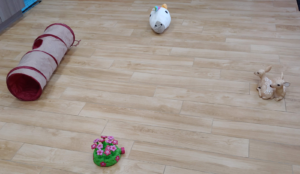
Goal: To allow puppies to explore multiple novel objects with a handler and to be comfortable with novel objects.
To prepare your designated space for this activity, please complete the following steps.
- Gather 5 novel objects. Remember variety when selecting objects.
- Arrange the objects in a circle spread apart enough for the puppies and handler to move around comfortably.
You are now ready to retrieve the litter of puppies you are working with.
- Allow the puppies to explore the room upon entering for up to a few minutes (consider needs of the puppies!).
- Invite the puppies to explore each of the objects with you.
- Continue around the circle in the same manner.
We have introduced our puppies to a variety of different sound items, but many items that play unusual sounds will also make flashing lights (e.g. traffic crossing buzzers, sirens – and conveniently for our socialization work, children’s toys). Our “sound activity rooms” can now be expanded to “Sound & light activity rooms”.
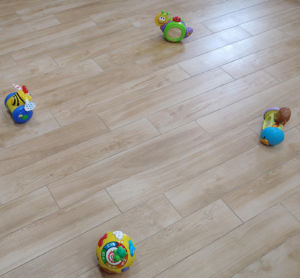
Goal: To allow puppies to explore multiple sound objects with a handler and to be comfortable with a variety of sounds, including items that both emit sound and light.
Equipment Required:.
- 3-5 objects that emit both sound and light.
- Socialization tracking sheets (to measure individual pup’s responses for future socialization sessions)
Method:
- Bring out a toy
- Allow pup to sniff and investigate it (NOT CHEW IT)
- When pup is comfortable, activate item a short distance from pup
- Reward pup when they are calm (not shut down) or for approaching the item
- Remove the item
- Re-present the item closer to the pup
- Reward pup for being calm (not shut down) or approaching the item
- Repeat with other items
Advancing this Skill:
- Start to ask the pup to follow simple cues (Sit, down, walking etc.) while the light/sound toy is activated
- Reward them for working with you and ignoring the item
Follow Me should now be without Mom – handlers can encourage puppies to follow verbally (either in one-on-one sessions or small groups).
Puppies can now begin to get used to settling inside a closed crate. You can review further information on crate settling here.
Some tips:
- Soft bedding and interactive toys will help to promote positive associations around the crate. Make sure to supervise puppies with bedding in case they chew it. If the puppy chews bedding, remove it for the safety of the pup and make sure you provide appropriate chew toys while the pup is in the crate.
- Pup should spend time in a crate away from their littermates but around people. Puppies need to learn to settle in their crates while people are around, as this will prepare them for crate time in their raiser’s home.
- Offer the pup a stuffed Kong or nylabone.
- Start off slowly to build positive associations: gradually increase time in crate from 5 min to 30 mins. Make sure to toilet the pup before and after.
All our work exposing pups to body handling, bonding with people and introductions to new environments begins to pay off as we introduce bath time.
Baths should be introduced slowly – expect to spend multiple sessions before you get the pup wet. Some key points to keep in mind:
- Introduce pups to the room prior to placing pup in hydrobath.
- No water initially and keep a non slip mat/towel on floor
- Keep pups in pairs or small groups, and utilise the support of known handlers and mom during early introductions.
- Use familiar toys, meals and voice and touch for reassurance and to build positive associations.
- Keep bath exposures short and positive.
Puppies can now be exposed to the strange feeling of a leash. This is an important step that must be taken before clipping a leash on a puppy and expecting it to follow you without hassle.
This activity requires full supervision to avoid puppies getting caught in the leash, chewing on each others’ or their own leash, or getting the leash caught on items in the environment.
Initial Introduction of the Drag Leash
Initially, short segments of leash (or another similar fabric- (rope, biothane, etc) can be clipped to the puppies’ collars during familiar activities (such as mealtime). Previous exposure to things like unusual textures and puppy coats should help this process.
Getting Pups Used to the Drag Leash
In following sessions, increase the length/weight of the attached leash. Supervise short play sessions, allowing the puppies to interact in a safe and supervised environment whilst the leash is attached. If the puppies try to play with or chew on the leash, make sure to redirect them to a suitable toy.
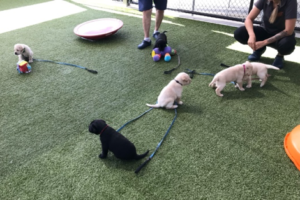
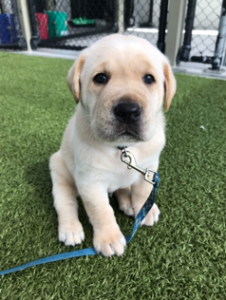
Adding the Handler
As puppies get used to the feel of a leash, you can start working with the puppy, using activities that the puppy already knows, with the main difference being that the handler is now holding the leash.
Do not use the leash to manage or direct the puppy – continue using voice, praise, toys and treats to direct the puppy in the activity. Make sure to manage the leash so that it does not get caught on items in the environment. Our goal is for the puppy to be desensitized to the leash and unconcerned about it. As handlers, we also want to avoid over-reliance on using the leash to manage or control the puppy – this is particularly important in these early weeks of leash introduction!
This activity allows you to transport puppies to new environments in a biosecure way. Having their littermates nearby will also support the puppies as they’re introduced to new sights, smells and sounds.
- Use bedding that has the pups/Brood scent on it
- Bring familiar toys
- Setting up a play area in an office, lounge, etc can be a useful way to introduce puppies to new people. Make sure any guests follow your protocol for handling (or not handling) puppies. Puppies do not need to interact with every stranger but will still benefit from meeting new people.
From six weeks, puppies have developed more robust proprioception abilities and are generally beginning to show more confidence and curiosity. You can begin to introduce more challenging surfaces in this interactive activity room. 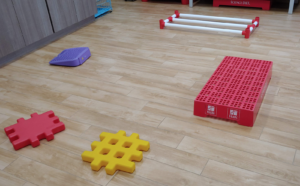
In the above image, you can see some age-appropriate examples: milk crates and pallets, waffle blocks, cavalettis and repurposed fitness equipment all offer some great challenges for puppies whilst being an appropriate height for short puppy legs.
Goal: For the puppy to confidently explore each surface with a handler.
- Choose a variety of 4-5 surfaces. Items can be different heights, just be mindful of the puppy’s height, do not make it unsafe for the puppy.
- Arrange the items in a circle with enough distance for the puppy to walk comfortably around each item.
You are now ready to retrieve the first puppy you are working with.
- Allow the puppy to explore the room upon entering for up to 30 seconds.
- Encourage the puppy to climb on or walk over all of the surfaces. Reward the puppy with praise, petting, and food rewards.
3. Continue around the circle in the same manner.
Please Note: If at any time the health or safety of the puppy is at risk (i.e., the puppy is eating something they aren’t supposed to, or the puppy has escaped the yard) please disregard this protocol and immediately address the concern.
Goal: To associate the cue “Puppy, Puppy” with being fed and to use this cue to call the puppies to you.
When to do the activity:
- Before feeding the puppies
After you enter the kennel, tap the bowls, and say “Puppy, Puppy” before putting the bowls down. This conditions the puppy to associate being fed after the bowls are tapped together and they hear “Puppy, Puppy”.
- Bringing the puppies in from the yard
Materials needed: Treat pouch with the litter’s food
When you are ready to leave the yard, say “Puppy, Puppy” to and give each puppy a treat. Exit the yard and encourage the puppies to follow you into the concrete walkway. When you are halfway to their kennel, give the puppies a treat and reward them for their hard work.
Use the cue “Puppy, Puppy” to bring the puppies in to their outside kennel. Say “Puppy, Puppy” and encourage the puppies to follow you. Give the puppies a treat when they come into their back kennel.
Troubleshooting:
If the puppies won’t come to you or follow you out of the yard:
- Decrease the distance between you and the puppies in the yard. Cue the puppy by saying “Puppy, Puppy” and treat them when they come to you.
- Incorporate the “Follow me with Mom” game to introduce the concept of following your voice.
In a few short weeks, puppies will need to travel to their new home in a car or van. Many organizations will use vans to transport dogs throughout the dog’s life. We can introduce these concepts early on and help our puppies become familiar with the car or van as a “new environment” before we even turn it on.
Initially, while the car/van is turned off, you can set up crates in the boot or back seat area of the car or van. Puppies can be introduced to this area in groups. Similar to our “introduction to Bath” concepts, you can feed pups small high-value meals such as yoghurt to build positive associations with the new environment.
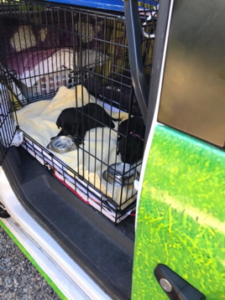
Another option is to set up a “play pen” in the back of the car/van using puppy fencing and toys.

Over the next few weeks, we can introduce more formal car/van travel. Make sure to develop this skill slowly – cars/vans can be noisy, smelly, moving things that puppies will need to get used to during their working life, so taking these initial introductions slowly helps you develop a solid foundation to build upon over the next few weeks.
Continue practicing the “wearing things” skill. This step positively introduces the concept and feel of a puppy coat.
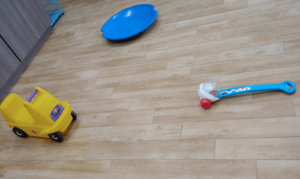
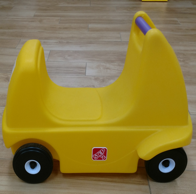
Goal: To allow puppies to explore multiple motion objects with a handler and to be comfortable with walking on unstable objects and moving objects.
To prepare the designated space for this activity, please complete the following steps.
- Gather 4-5 motion objects. Remember variety when selecting objects.
- Arrange the objects in a circle spread apart enough for the puppies and handler to move around comfortably.
You are now ready to retrieve the litter of puppies you are working with.
- Allow the puppies to explore the room upon entering for up to 30 seconds.
- Encourage the puppies to explore each of the objects with you.
- Continue around the circle in the same manner.
More Resources
IWDA members can access the following articles, presentations and lectures that can help you upskill and build upon your socialization program. Discover some of the science behind our Early Socialization Program. Not a member? Learn more here.
General Socialization:
- Puppy socialization for handling, presented by Doug and Colton Johnson
- Puppy socialization, presented by Jane Russenberger
- Critical periods of socialization and their impact on temperament in the dog, presented by Jane Russenberger
Measuring Behavior:
- Learn about the Behavior Check List used to systematically measure puppy behaviour, how to run a GDBART puppy test, and hone your skills in one of our recorded BCL workshops run by specialist Helen West.
Puppy socialization to improve your working dog program:
- The effects of puppy potty training on Indiscriminate relieving in training, presented by Dr Lynna Feng
- The effect of maternal style on later puppy behavior in Canine Companions dogs, presented by Brenda Kennedy
- Development and heritability of cognitive traits in Canine Companions dogs, presented by Emily Bray
- Neonatal care, presented by Emmanuel Fontaine
- These articles are relevant, but older and less content is available:
- Neuromotor development in puppies presented by Dr B. Pierce
- From Puppyhood to Adolescence: Longitudinal Cognition Study presented by K. Levy
- What helps and what hinders assistance dog/puppy raising practices?, presented by Doc Loc Mai
